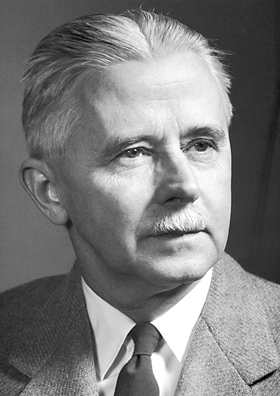Haldan Keffer Hartline

Nobel Laureate and OSA Honorary Member Haldan Keffer Hartline was born in Bloomsburg, Pennsylvania, USA, on 22 December 903. Hartline’s parents, both teachers, encouraged their son’s early educational endeavors. But it was his father’s work as a biology professor that enticed Hartline to pursue his interest in the natural sciences.
At Lafayette College in Easton, Pennsylvania, Hartline participated in undergraduate research projects in biology. His first scientific paper concerned visual responses of land isopods. He spent his summers at the Marine Biological Laboratory at Woods Hole.
After graduating in 1923 Hartline entered the Johns Hopkins University where he was encouraged to continue his vision research in the Department of Physiology under E. K. Marshall and C. D. Snyder. Snyder let Hartline use his Einthoven string galvanometer enabling Hartline to study the retinal action potential using frogs, decerebrate cats and rabbits. He learned to obtain electroretinograms from intact animals, and recorded clearly recognizable retinal action potentials from human subjects. He also used intact insects for quantitative studies.
After receiving his M.D. from Johns Hopkins in 1927, a National Research Council Fellowship enabled him to study mathematics and physics. He spent two years in the Physics Department at Johns Hopkins taking courses and working as a student. In 1929 Hartline received an Eldridge Reeves Johnson Traveling Fellowship from the University of Pennsylvania, and used the award to study at the University of Leipzig and the University of Munich.
In the spring of 1931 Hartline returned to the U.S. taking a position at the University of Pennsylvania, in Philadelphia, in the Eldridge Reeves Johnson Foundation for Medical Physics. At the Johnson Foundation Hartline began his studies on the activity of single optic nerve fibers in the eye of the horseshoe crab, Limulus, recording the responses of receptor units under various conditions of stimulation and adaptation. In the mid 1930s he undertook the single fiber analysis of the optic responses of the vertebrate retina, principally in the eye of the frog. In the early 1940s Hartline worked on problems of night vision in human subjects.
In 1949 Hartline accepted a position at Johns Hopkins University as professor of biophysics and chairman of the Thomas C. Jenkins Department of Biophysics. There, he began with his colleagues work on intracellular recording from receptor units in the Limulus eye. It was at that time that he took up the study of the inhibitory interaction in the Limulus retina, begun briefly several years before. In 1963 he accepted a professorship at the Rockefeller University (then the Rockefeller Institute).
Hartline received numerous honors for his vision work, most notably the 1967 Nobel Prize for Physiology or Medicine for discoveries concerning the primary physiological and chemical visual processes in the eye. Other awards include the William H. Howell Award; the Howard Crosby Warren Medal from the Society of Experimental Psychologists; the Albert A. Michelson Award from Case Institute of Technology; an LL. D. from the Johns Hopkins University; honorary degrees from Lafayette College, the University of Pennsylvania and Albert-Ludwigs University; and the Lighthouse Award.
He was a member of the National Academy of Sciences, the American Academy of Arts and Sciences, the American Philosophical Society, American Physiological Society, OSA, the Biophysical Society, and a foreign member of the Royal Society (London).
Haldan Keffer Hartline died 17 March 1983.
But what is more, if we have succeeded in adding to the basic understanding of our universe and ourselves, we will have made a contribution to the totality of human culture.
Document Created: 26 Jul 2023
Last Updated: 28 Aug 2023
